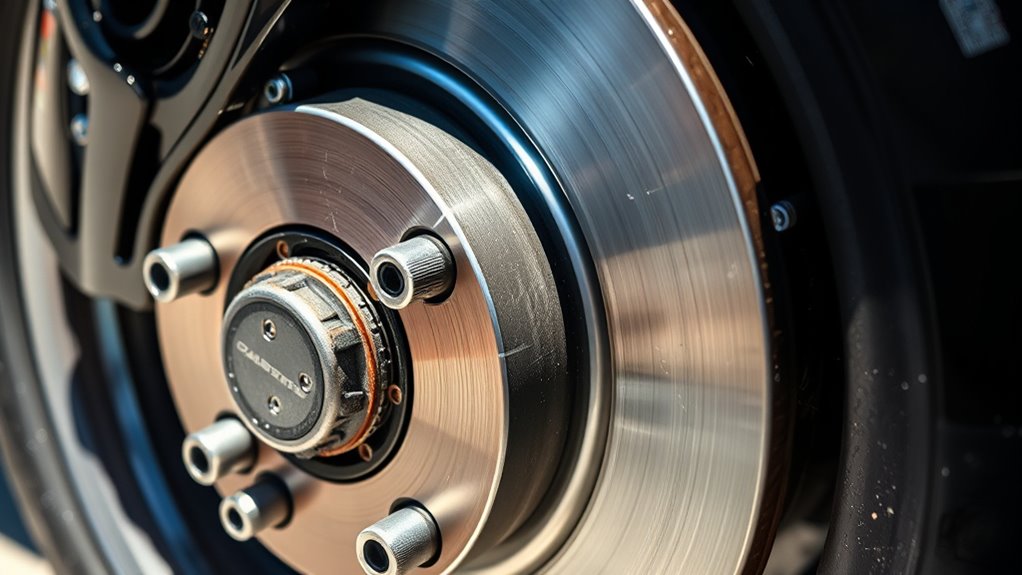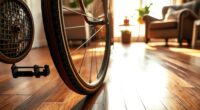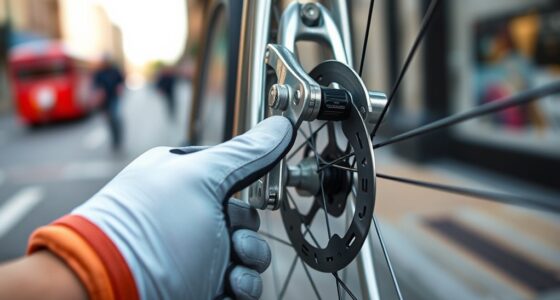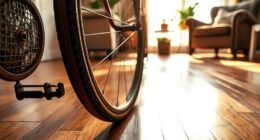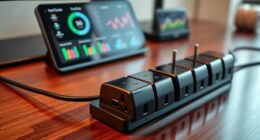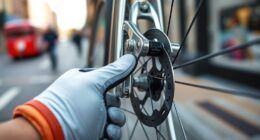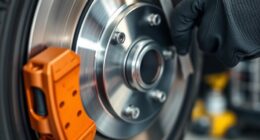To diagnose brake rub, listen for squealing or grinding noises when braking and check for uneven wear or thinning brake pads. Inspect the calipers for misalignment or sticking, as these can cause uneven contact with the rotor. Look for signs of pad wear and uneven surface contact, which often lead to noise and pulsing sensations. Addressing these issues early prevents further damage. If you want to know more about fixing and preventing brake rub, keep exploring these tips.
Key Takeaways
- Listen for screeching or grinding noises during brake application as signs of brake rub.
- Inspect brake pads for uneven wear, thinning, or damage that may cause contact with the rotor.
- Check caliper alignment and operation to ensure proper clearance and prevent uneven pad contact.
- Look for symptoms like squealing, pulsing, or persistent rubbing as indicators of brake issues.
- Perform regular maintenance and prompt repairs to address sticking calipers or misalignment early.

If you notice a screeching or grinding noise when you brake, it’s likely due to a brake rub issue. This sound typically indicates that the brake components are not functioning properly, and ignoring it can lead to further damage or unsafe driving conditions. One common cause of brake rub is uneven brake pad wear. Over time, brake pads can wear down unevenly, causing the pad to come into contact with the rotor at the wrong points. When pads become too thin, they lose their ability to clear the rotor surface properly, resulting in a persistent rubbing sound. Regularly inspecting your brake pads for signs of wear can help catch this early, but if you notice uneven wear patterns, it’s a sign you need to replace the pads or have a mechanic check for underlying issues.
Another critical factor that can lead to brake rub is caliper alignment. The caliper’s role is to press the brake pads against the rotor evenly, enabling smooth braking. If the caliper is misaligned or stuck, it can cause the pad to contact the rotor unevenly or continuously, producing noise and uneven brake pad wear. Misalignment may stem from corrosion, dirt, or damage to the caliper slides or mounting hardware. When the caliper isn’t aligned correctly, it can also lead to uneven brake pad wear, further aggravating the problem. Ensuring that the calipers are properly aligned and functioning smoothly requires regular maintenance and inspection. If you notice your brakes squealing or pulsing while braking, that might be a sign the caliper is not aligned or is sticking. Recognizing the importance of proper maintenance can help prevent these issues from escalating.
Frequently Asked Questions
Can Brake Rub Cause Long-Term Damage to My Vehicle?
Yes, brake rub can cause long-term damage to your vehicle. Continuous rubbing can accelerate brake system deterioration, leading to worn-out pads and damaged rotors. It might also indicate wheel alignment issues, which, if left unresolved, can affect your vehicle’s handling and tire wear. Addressing brake rub promptly helps prevent costly repairs and guarantees your vehicle remains safe and reliable on the road.
How Often Should I Check for Brake Rub Issues?
You should check for brake rub issues during regular brake inspections, ideally every 10,000 to 15,000 miles or when you notice unusual noises or vibrations. Keep an eye on your tire alignment, as misaligned tires can cause brake rub and uneven wear. If you experience any brake squealing, pulling, or a burning smell, inspect your brakes promptly to prevent further damage and make certain of safe driving.
Are There Specific Driving Habits That Increase Brake Rub Risk?
You might notice more brake rub if you tend to drive aggressively or frequently perform heavy braking. Sudden stops and quick accelerations cause your brakes to work harder, increasing the chance of rub issues. Plus, aggressive driving can cause your brake components to shift or wear unevenly, making rub more likely. To reduce this, try to brake smoothly and anticipate stops, giving your brakes a gentler, more consistent workload.
What Tools Are Needed for a DIY Brake Rub Diagnosis?
To diagnose brake rub yourself, you’ll need some tool essentials like a jack, jack stands, and a flashlight for a thorough brake inspection. A pry bar helps check for caliper or pad issues, while a mechanic’s stethoscope can pinpoint unusual noises. Don’t forget gloves and safety glasses for protection. These tools enable you to inspect the brake components closely, identify potential causes of brake rub, and decide if professional help is necessary.
When Should I Seek Professional Help for Brake Rub Problems?
You should seek professional help when brake noise and brake vibration persist despite your efforts. While some issues can be DIY fixes, ongoing symptoms often indicate serious problems like warped rotors or damaged calipers. Ignoring these signs can jeopardize safety and lead to costly repairs. If you notice uneven braking, squealing, or a pulsing pedal, it’s time to consult a mechanic to ensure your brakes function properly and safely.
Conclusion
To avoid brake rub issues, always perform thorough inspections if you notice any noise or uneven wear. For example, a driver once ignored a slight squeal, only to find warped rotors later—costing them more time and money. Regular checkups, including checking for debris or misaligned calipers, can save you from costly repairs. Stay vigilant and address any signs early—your brakes depend on it, and so does your safety.
